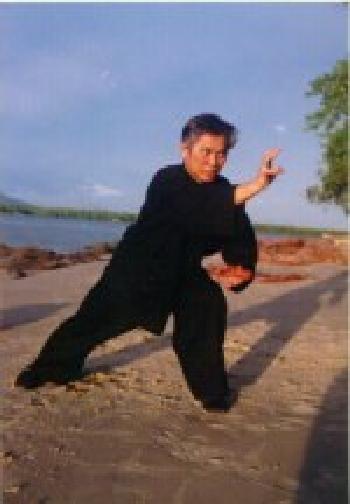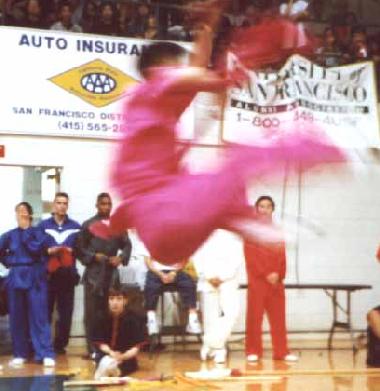October 2005 (Part 2)
SELECTION OF QUESTIONS AND ANSWERS

Sifu Wong demonstrating a tiger pattern called “Fierce Tiger Snatches Goat” from the famous Hoong Ka kungfu set “Tiger-Crane”
Question 1
I am very proud of my Sifu for he shows us how good kung fu is without showing us anything. He lets us discover the depth of training never revealing to us what we are not ready for but at the same time giving us something new as soon as he deems us ready for it. After reading your book I have learned to appreciate these qualities and more about my Sifu.
However, I am a bit worried about the type of kung fu I'm studying. The Hoong Ka you mentioned and the Hoong Ka I came across on the Internet mention the tiger, dragon, crane, leopard and snake. In the kung fu I am studying the five animals are dragon, crane, snake, tiger but monkey instead of the leopard! Is this possible? Are there different types of Hoong Ka?
— Dr. Gauci, Malta
Answer
Congratulations for having a good kungfu teacher. Honour him and practice in a way that he will be proud of you.
You need not worry that in your style of kungfu the “five animals” are dragon, crane, snake, tiger and monkey instead of leopard. You did not mentioned that your style was also Hoong Ka, but presuming that it is, there is nothing wrong at all if your style has monkey instead of leopard in your system. This is certainly possible.
Yes, there are different types of Hoong Ka. Some emphasize the tiger and the crane, and pay little attention on the other three animals. Some emphasize only the tiger, especially the tiger claws. Some just focus on the fist.
Question 2
Also we use belts to show rank in our school. I thought this was a Japanese tradition. Please enlighten me on these points.
Answer
Yes, this is a Japanese tradition. But some masters teaching traditional kungfu also use the belt system.
If your teacher finds the belt system useful, you should not have prejudice against it.
Question 3
I'm sure you are wondering why I have not voiced these concerns with my Sifu. Well the truth is I have and he just answered me by saying “I don't know much about the history or types of kung fu. All I can tell you is that I know my kung fu is good and I am willing to show you if you are willing to learn”. I know that this answer is not what you would expect from a teacher but I know this to be the truth and because of my teacher's origins and background.
Answer
Your sifu gave an excellent answer. It is more impressive that he was honest; he did not try to cook up an answer.
You are mistaken. Your sifu's answer is one that I would expect from a good kungfu master. Indeed, kungfu warriors do not worry about the history of their style, what they are concerned is that their kungfu is effective. On the other hand, kungfu scholars talk about history and philosophy, but do not practice sufficiently.

A wushu practitioner demonstrating a magnificient wushu movement while performing with a kungfu knife (or broadsword)
Question 4
Today is my first Nan Quan lesson. Can you give me advice on what to be careful while learning Nan Quen, like possible injury?
— Su Yee, Malaysia
Answer
A common injury many wushu students sustain is hurting their knees. Nan Quan, or Southern Fist, is one of the seven established forms of wushu. This is because as wushu is mainly performed for demonstration, many instructors ask their students to bend deeply in their stances, especially the Bow-Arrow Stance and the False-Leg Stance. This is beautiful to watch but is bad for the knees. If you wish to bend deeply to have beautiful stances, one way to prevent knee problems is to rotate your knees after each practice session.
Rub your palms to warm them, place the palms on your knees, bend them slightly and rotate about 30 times one side, and then 30 times the other side. Then drop your hands on your sides, stand upright and be relaxed, and keep still for about 5 minutes. If you start to sway or move, just follow the movements spontaneously. This is one of the exercises in Shaolin Eighteen Lohan Hands, and is called “Spiritual Crane Rotates Knees”. It is effective for preventing and overcoming knee problems.
Question 5
What health benefit does Nan Quen or wushu bring to us
Answer
Nan Quan, which literally means “Southern Fist”, is a form of wushu. If you practice it correctly, you will be agile, flexible, fit and have better stamina. Your movements will also be elegant.
Question 6
My adult son has some psycho-neurological problems. I would like him to be examined and treated him with methods of Chinese medicine. Could you get me information where I can do this? And how many time does it take approximately? And how much does it cost?
— Yuri, Russia
Answer
You should send your son to a good doctor of traditional Chinese medicine. If you cannot find one in your country, you may consider finding one in China. Perhaps you can write to some hospitals using traditional Chinese medicine in Bejing or Shanghai.
How long the rreatment will take, and how much does it cost will depend on numerous factors like how series is your son's problems, how effective is the treatment, and how much the doctor prices his skills. You will have to negotiate these with the doctor.
What is referred to as psycho-neurological problems in conventional Western medicine is referred to as problems of the “heart” in traditional Chinese medicine. “Heart” here means the mind, and refers not just to the mental but also the emotional and the spiritual.
You can get some useful information about the traditional Chinese medical view on “heart problems”, or psychoneurological problems, from my book, “The Complete Book of Chinese Medicine”.
Records show that traditional Chinese medicine is effective in overcoming “heart problems”. It is therefore worth your effort and time in seeking a good doctor of Chinese medicine for your son.
Question 7
Tell me Sifu Wong, why and what is the purpose of placing our middle finger on our navel and press about 10 times and gently massage the baihui vital point every time before we practices.
— John, Malaysia
Answer
The purpose of gently pressing your naval and massaging your baihui vital point (at the crown of the head) is to stimulate your energy to flow. This technique is recommended for those who practice from my books. But those who learn from me or any of our certified Shaolin Wahnam instructors need not do so because they can stimulate their energy flow in other more effective ways.

Combat application is an essential aspect of kungfu training, including Hoong Ka Kungfu. This old photography shows Sifu Wong and his student, Yau Ba, applying Hoong Ka Kungfu for sparring.
Question 8
I have been practicing Hung Gar for three months and my instructor does not teach sparring. He says that it is not appropriate for this art because it was not practiced like this traditionally and Hung Gar is dangerous at best (and I can see what he means from some of the moves). So is sparring in Hung Gar a good idea or not because I am not sure what to do.
— Grant, England
Answer
Hoong Ka (Hung Gar) Kungfu was practiced in the past as a martial art. Sparring was an integral part of any martial art training, including Hoong Ka of course. If you practice Hoong Ka traditionally, then sparring is essential.
But today many people do not practice Hoong Ka as well as other kungfu styles traditionally. The practice of Hoong Ka as well as other kungfu styles today can be classified into two broad categories — those who practice only the external forms with no combat application, and those who use other martial techniques, particularly from Karate and Kick-Boxing, for their combat application.
Anything done wrongly can be dangerous. Walking down a street, if done wrongly, is more dangerous than sparring.
When done correctly, sparring is not only safe, it is also fun and educational. You can find a lot of video clips of such sparring in the Video Galore of my website, where you can find a lot of laughter and comradeship. Many of these video clips are from Shaolin Wahnam UK.
Question 9
I once asked you a question concerning the method of qinggong, and you told me that it was dangerous to practice qinggong without a qualified master. However, I was just wondering if it would be dangerous if I simply follow the instructions and avoid harm.
For example, by using nei dan training, by practicing Six Healing Sounds, Microcosmic Orbit, qi permeating technique, Tao Yin, Chi Nei Tsang, etc., one can clear any qi stagnation and clear blockages while strengthening qi. This balances the heavy wai dan jumping training of qinggong with nei dan. Also, I know that qinggong requires abundant dantien qi so I practice Dragon and Tiger Breaths to fill my dantien.
I was just wondering if a master really is needed or is it still possible to practice qinggong with these methods. I would be very grateful if you can help answer this question because I don't want to endanger my health and want to choose the best way.
— Jax, USA
Answer
It is not absolutely necessary to learn from a master, and it is still possible to practice qinggong with the methods you have described, but it is most likely that not only you will waste your time but worse you will injure yourself seriously before you have gone through half the methods.
All those who have injured themselves said the same thing when they started, “I simply follow the instructions and avoid harm.” The irony is that despite what they had said to themselves, they simply did not follow the instructions and did not avoid harm.
Your main problem, like those who seriously injured themselves training wrongly, is that you fail to differentiate between techniques and skills. You may follow the techniques according to how they are described, but you will still do them wrongly. For example, the “shi” sound in the Six Healing Sounds can be pronounced in more than a hundred ways. How do you know which one of the countless ways of pronunciation is correct?
The manner you list the various chi kung methods — like nei dan Six Healing Sounds, Microcosmic Orbit, qi permeating technique, Tao Yin, Chi Nei Tsang and Dragon Tiger Breaths — sounds as if you could pick up these advanced arts of chi kung as easily as you pick up a book. You should learn to have more respect for chi kung. If one can so easily master, or even learn, these arts from reading, there is nothing great about them.
Take an analogy from surgery. You can also easily pick a book on surgery and read it. You can also simply follow the instructions and avoid harm, but you will most likely kill your patient you operate on.
LINKS
Selected Reading
- The Shaolin Arts are Not merely for Cultivating Martial Arts — Sifu Emiko Hsuen
- How do Masters Spar?
- Important Questions Regarding Practice after Intensive Chi Kung Course — Chong Baa Chuah
- Index of the Question-Answer Series
- Video Series — Can Kungfu be used for Combat?
